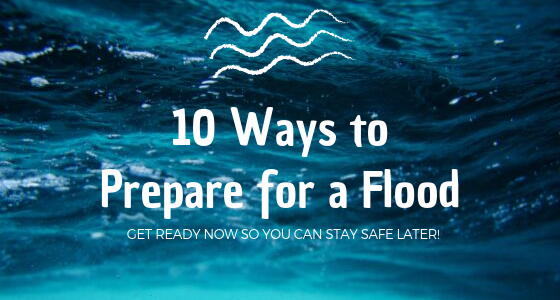10 Ways to Prepare for a Flood

Flooding can occur anywhere, and not just during a hurricane or storm. Floods can be caused by melting snow, levee breaking, water runoff, river overflow, new land development, etc. Just because you haven’t experienced a flood in the past, doesn’t mean you won’t in the future!
Here are 10 ways you can prepare now:
1) Make sure you have a flood insurance policy
Most homeowner’s insurance policies do not include flood damage as a covered peril. If you live in a Special Flood Hazard Area or high-risk area and have a federally-backed mortgage, your lender requires you to have flood insurance.
2) Familiarize yourself with your flood policy and what it covers
Make sure your coverage limits are adequate based on the value of your property and contents. Consult with your insurance agent annually to discuss any changes you may have encountered that year.
3) Itemize and photograph your possessions
Keep documentation of all your possessions and their value so that in the event of a loss, the claims process is as smooth as possible.
4) Have your insurance agent’s contact info handy at all times
Store your flood insurance agent’s contact info in your phone or somewhere easily accessible in the event a flood occurs unexpectedly so that you can file a claim quickly.
5) Have an emergency kit prepared
Keep an emergency kit that is easy to store and access. Good items to have on hand include a cell phone charger, extra batteries, a flashlight, a battery-powered or crank radio, local maps, and a change of clothes.
6) Store important documents in a safe, dry place
Make sure documents such as birth certificates, passports, insurance policies, wills, deeds, and financial account information is stored in a watertight container so as not to be damaged or lost.
7) Know your evacuation route
You can find your evacuation route by checking this interactive map by the SCDOT. Be familiar with the most efficient way to evacuate and have a plan in place that your family is also aware of.
8) Have a phone plan
Pick one person for each family member to report their safety and whereabouts. Send texts or emails to keep phone lines free for emergency workers. Have emergency contact info stored in your phone already.
9) Have a meeting place
Make sure all family members know where your meeting place is either before or after evacuating. Have a meeting place near your home if you are evacuating together, and a meeting place outside of harm’s way if you are evacuating separately.
10) Have a plan for your pets
Have a separate emergency pet kit ready including food, medicine, ID tags, etc. Have your pet micro-chipped and make sure your contact information is up to date. Keep a list of pet-friendly hotels and nearby boarding facilities. Always take your pet with you if possible!
For more information on planning, visit
www.ready.gov/make-a-plan .
If you need to review your current flood coverage or homeowners insurance coverage, schedule a consultation with us today! Just click here.

Thanks for sharing